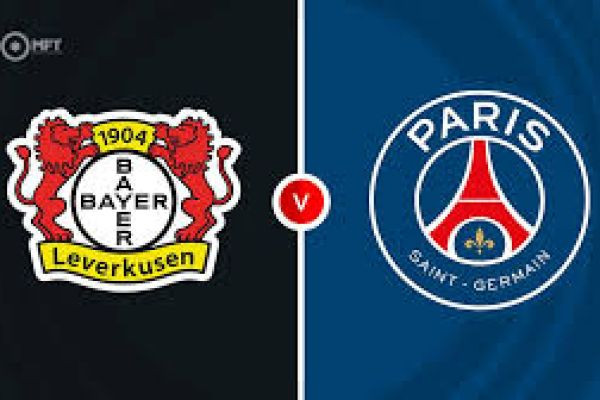This fixture pits Bayer Leverkusen, rejuvenated under the management of Kasper Hjulmand, against the reigning Champions League title holders, Paris Saint-Germain. While PSG has historically dominated this head-to-head (winning both fixtures in the 2013/14 Round of 16 with a commanding 6-1 aggregate scoreline), the current tactical context presents a far more intriguing contest. This match represents a fascinating stylistic clash between Leverkusen’s energetic, progressive pressing and PSG’s possession-dominant, star-studded attack.
Bayer Leverkusen's Pressing Revolution (Approx. 3-4-3)
Since the arrival of Hjulmand, Leverkusen has transitioned into a high-intensity, vertical side focused on quick transitions and overwhelming the opponent's build-up. They typically deploy a fluid 3-4-3 formation that morphs into a 5-4-1 without the ball.
Key Strengths and Tactics:
High-Pressure Blocks: Leverkusen's primary weapon is their pressing. They aim to force rapid turnovers in the opponent's defensive third, often utilizing a man-oriented press that targets specific PSG midfielders like Vitinha or the center-backs. This requires immense energy from players like the attacking duo of Maza and Poku, who are crucial in setting the pressing triggers.
Wing-Back Width: The full potential of the 3-4-3 is unlocked by the wing-backs, notably Grimaldo. Their width stretches the pitch, either creating one-on-one situations high up the field or allowing central runners (Maza, Kofane) space in the box. Grimaldo's crossing and set-piece delivery are major threats.
Midfield Engine: The central partnership, often featuring Exequiel Palacios (if fit) or Gustavo Garcia, is tasked with ball recovery and quickly feeding the vertical passes forward. Leverkusen excels at playing through the lines rather than around them, which will test PSG's positional discipline.
Vulnerabilities:
Defensive Stability: Leverkusen has shown defensive fragility this season, only keeping a handful of competitive clean sheets. Their commitment to the high line can be exposed by fast, intricate passing, leaving their three center-backs vulnerable to balls played into the channels, especially against PSG's pacey forwards.
Midfield Gaps: If PSG's midfield can beat the first press, the high positioning of the wing-backs and the sheer verticality of the team can leave large gaps between the lines, creating pockets of space for PSG's creative players like Kvaratskhelia or the returning Ousmane Dembélé to exploit.
Paris Saint-Germain's Positional Play (Approx. 4-3-3)
As Champions League holders, PSG, led by Luis Enrique, prioritizes control, possession, and positional superiority. While their recent domestic form has been mixed (consecutive league draws), they have been perfect in the Champions League, showcasing an ability to win even when not at their best.
Key Strengths and Tactics:
Overload and Isolate: PSG often uses numerical superiority in midfield (the 4-3-3 structure) to break down low blocks, but against Leverkusen's high press, they will focus on quick passing triangles to bypass the pressure. The full-backs, particularly Hakimi and Mendes, provide attacking thrust high up the pitch, freeing up space for attackers to cut inside.
Attacking Depth: The return of Ousmane Dembélé offers Luis Enrique crucial attacking flexibility. Whether he starts or comes off the bench, his dribbling, creativity, and ability to interchange with Gonçalo Ramos or Bradley Barcola adds unpredictability. Ramos provides a focal point, contrasting with the fluid runs of the wingers.
High Press Resistance: Luis Enrique’s philosophy demands that his team is comfortable taking risks in build-up. They will use their goalkeeper (Lucas Chevalier) as a deep passing option to draw in Leverkusen's press before exploiting the space created with long, accurate balls to the wings.
Vulnerabilities:
Tempo Lulls: PSG can sometimes settle into periods of sterile possession, which invites pressure. If Leverkusen can maintain intensity for 90 minutes, PSG's creative tempo could drop, allowing the hosts to reassert control.
Marquinhos' Absence/Fitness: While Marquinhos is returning, any instability in the defense could be costly. Leverkusen's vertical runs and relentless pursuit of the ball mean that any momentary lapses in concentration or organization could result in an immediate scoring chance.
Match Prediction and Key Battles
This fixture is poised to be an open contest. Leverkusen's confidence from their unbeaten domestic run under Hjulmand combined with their home advantage (they thrive at the BayArena) makes them a formidable opponent. PSG, however, holds the technical quality and Champions League pedigree to find a breakthrough, even when below par.
The game will likely be decided by two key battles:
Leverkusen's Midfield Press vs. PSG's Build-up: If Leverkusen can consistently turn the ball over high, they will generate chances. If PSG's central midfield (Vitinha, Lee Kang-In) is press-resistant, they will control the game and dictate the pace.
Kofane vs. PSG's Center-Backs: Kofane's goalscoring run is pivotal for the hosts. His movement against the defensive pairing of PSG will determine how much PSG is forced to drop deep and whether they can comfortably play out from the back.
Predicted Scoreline: Bayer Leverkusen 1-2 Paris Saint-Germain. PSG's superior depth and match-winning attacking talent, even with minor injury concerns, is likely to prove the difference in a high-scoring, entertaining affair.








